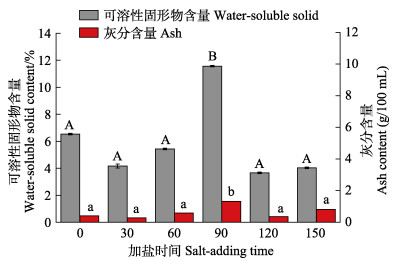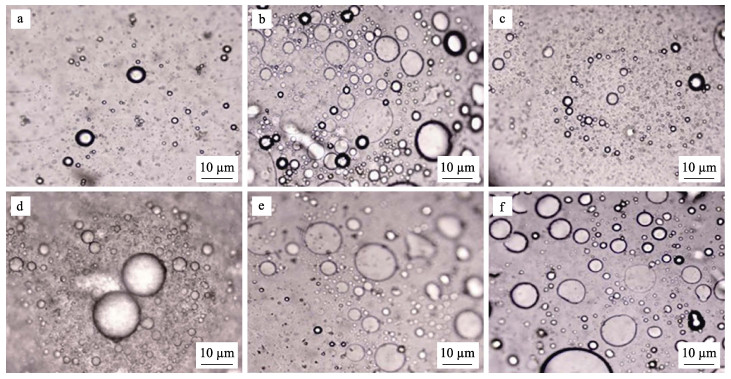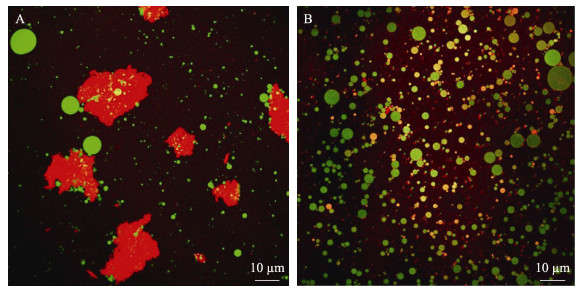2. 宁夏贺兰山东麓葡萄产业园区管理委员会 宁夏 银川 753000
2. Administrative Committee of Grape Industrial Zone of Ningxia Helan Mountain East Foothill, Yinchuan, Ningxia 753000, China
乌鳢(Channa argus)是鳢科(Channidae)、鳢属(Channa)鱼类,是一种备受欢迎、市场价值高的淡水鱼(Sahid et al, 2018; Zubaidah et al, 2015)。乌鳢富含优质蛋白质,目前对其利用以鱼片产品加工为主,而鱼头、鱼骨等加工副产物利用率较低,不仅造成了资源的浪费,还可能污染环境。陈飞东等(2013)研究发现,乌鳢鱼头富含Ca、Fe、Cu、P等矿物质元素,氨基酸组成丰富,必需氨基酸比例较高,还含有丰富的磷脂和不饱和脂肪酸。我国素有熬制鱼头汤的饮食习惯,其味道鲜美,深受消费者喜爱。因此,将乌鳢鱼头加工成鱼头汤制品,不仅具有较好的营养和食疗作用,还能满足人们的饮食需求,市场前景广阔。在鱼汤熬制工艺方面,除了加热方式、熬煮时间以外,在熬制中添加的调味料也是一个重要的因素。食盐是人们饮食中膳食钠摄入的主要来源,食盐的添加会影响汤在熬煮过程中的各营养物质的含量及产品品质,而目前对这方面的研究还较少。另外,随着现代食品胶体研究技术的发展,汤中微纳米颗粒(micro and nano particles, MNPs)的形成机制与功效成分的生物学效应引起了科研人员的关注。
本研究阐述了乌鳢鱼头汤加工工艺中的食盐添加对各营养物质溶出规律的影响,并分析了汤中MNPs的微观结构及其对体系稳定性的影响,以期为新型鱼汤产品的工业化、标准化生产提供参考。
1 材料与方法 1.1 材料与试剂新鲜乌鳢购于江苏省镇江市吉麦隆超市,宰杀后取鱼头,捣碎备用;食盐(食品级),江苏省盐业集团公司;核苷酸标准品,上海碧云天生物技术有限公司;福林酚试剂、浓硫酸、NaOH、KOH、三氯乙酸(分析纯),国药集团化学试剂有限公司;尼罗红,阿拉丁试剂(上海)有限公司;Fast Green FCF,美国Sigma公司。
1.2 仪器与设备UV1601紫外分光光度计,北京瑞利分析仪器公司;数显恒温水浴锅,江苏省常州市亿能实验仪器公司;Eppendorf AC22331 Hamburg离心机,德国艾本德股份公司;激光共聚焦显微镜,德国蔡司股份公司;CR-400色度计,日本柯尼卡美能达;LC-20AD高效液相色谱,日本岛津公司;S-433D全自动氨基酸分析仪,德国Sykam公司;手持式数显糖度计PAL-1,日本ATAGO公司。
1.3 实验方法 1.3.1 乌鳢鱼头汤的制备取1.1制备的鱼头原料,用料酒和少量姜块腌制30 min,沥干备用。锅内放入约50 mL大豆油,放入鱼头(250±5) g煎炸50 s至鱼头变色,转入汤锅中加水(料液比为1∶6)大火(98℃)熬煮30 min,然后转小火(90℃)熬制,分别在熬煮至0、30、60、90、120和150 min时添加1% (w/v)的食盐,总熬煮时间为150 min,起锅后除去上层的油层,选取下层的鱼汤进行后续分析。在整个熬煮过程中由于水分蒸发,最终汤的体积约为最初加水体积的45%。
1.3.2 水溶性蛋白测定采用福林酚法进行测定(Lowry et al, 1951)。用牛血清白蛋白标准溶液制作标准曲线,结果以g/100 mL表示。
1.3.3 总糖测定采用苯酚–硫酸法(Cheng et al, 2019),并做适当修改。取5 mL样品于离心管,加入2 mL 10%的苯酚溶液沉淀蛋白质,10 min后离心(4000 r/min, 15 min)。收集上清液,取1 mL加入1 mL苯酚(5%),然后缓慢加入浓硫酸,轻轻摇晃,于室温下反应20 min,冷却后在470 nm下测定吸光值。结果以mg/100 mL表示。
1.3.4 灰分测定取3 mL鱼头汤样品于坩埚中,用小火烧至无烟后放入马弗炉中加热4~6 h,冷却后放入干燥器中称重。结果以g/100 mL表示。
1.3.5 固形物含量测定可溶性固形物含量采用手持式数显糖度计测定。
1.3.6 核苷酸测定参考Qiu等(2016)的方法。取5 mL样品和10 mL高氯酸(10%)混合2 min,超声10 min后离心30 min (8000 r/min, 4℃)并收集上清液,如此重复2次,最后用NaOH将上清液pH调至6.0。静置后取上清液并用超纯水稀释至50 mL,用尼龙注射器过滤,收集于棕色瓶中,用高效液相色谱仪分析。
1.3.7 游离氨基酸测定参照Tanimoto等(2013)的方法。将2 mL样品和15 mL三氯乙酸混合,超声处理10 min后静置1 h。然后离心10 min (10 000 r/min, 4℃),取5 mL上清液调节pH至2.0,加水定容至10 mL。过滤后收集到棕色进样瓶中。采用全自动氨基酸分析仪进行检测。
1.3.8 色度的测定用色度计测定。L*为亮度,a*值表示从绿色(–)到红色(+)的变化,b*值表示从蓝色(–)到黄色(+)的变化(李钊, 2010; 王楠, 2013)。
1.3.9 微观结构观察用80目漏勺过滤除去汤中的悬浮物,然后取20 μL样品置于灭菌载玻片上,用光学显微镜观察不同样品中胶粒的形态特征。参考Lopez等(2011)的方法,用激光扫描共聚焦荧光显微镜(LCSM)观察汤样中MNPs的形态结构及分布,采用63×/1.40油镜成像,氩激光器激发波长为488 nm,He-Ne激光器为543 nm。
1.3.10 鱼头汤胶体颗粒稳定性测定参照Lü等(2020)的方法略有改动,用纳米粒度仪测量各样品中的微纳米胶粒的平均粒径和多分散系数(polydispersity index, PDI)。
1.4 数据分析所有实验重复3次,每个样品设3个平行,结果取均值。用SPSS软件进行差异显著性分析,以P < 0.05作为标准。采用Origin 8.0软件绘图。
2 结果与分析 2.1 食盐添加对鱼头汤中蛋白质和总糖含量的影响鱼肉中的主要成分肌球蛋白和肌动蛋白以及原肌球蛋白、肌钙蛋白、结缔蛋白等均属于盐溶性蛋白,在一定的离子强度下能被溶解,因此,在熬煮过程中食盐的加入导致蛋白质被溶解向汤中迁移。而肌肉内部的糖类等营养物质也被动迁移到汤中。不同加盐时机对汤中蛋白质和糖含量的影响见图 1。由图 1可见,熬煮60 min时加盐,汤中蛋白质的含量最高,而90 min与60 min无显著性差异(P > 0.05)。鱼头在熬煮过程中,蛋白质组织结构被破坏,在60~90 min时加入盐使汤汁中的渗透压增大,促使结构受到破坏的蛋白质向汤中迁移。NaCl在水溶液中会以Na+和Cl–的形式分别与蛋白质链上的带负电和正电的氨基酸残基结合,静电相互作用使鱼头组织中的蛋白质在汤中的溶解性增大。而在90 min以后加盐,汤中蛋白质含量明显降低,这可能与长时间熬煮导致蛋白质大量溶出并在汤中发生聚集沉淀有关,而此时加入NaCl已经不足以使其与蛋白发生相互作用而阻止聚集(Cui et al, 2018; Chen et al, 2018; Lanier et al, 2005)。朱琳芳(2012)发现,在初始阶段加入食盐后,对鳙鱼(Aristichthys nobilis)鱼头进行熬煮,汤中的氨基态氮和蛋白质含量会随时间延长而增加并趋于稳定,认为是蛋白质的热降解并不断溶出的结果。

|
图 1 不同加盐时间对鱼头汤中水溶性蛋白和总糖迁移的影响 Fig.1 The migration of water-soluble protein and total sugar in the soup at different salt-adding time 不同大写字母表示水溶性蛋白含量存在组间差异,不同小写字母表示总糖含量存在组间差异(P < 0.05)。 Different uppercase letters indicate significant difference in water-soluble protein content between groups, and different lowercase letters indicate significant difference in total sugar content between groups (P < 0.05). |
糖是产品风味生成的重要前体物之一。由图 1可知,总糖的迁移规律与蛋白质类似,在90 min加盐时鱼汤总糖含量最高,60 min加盐时总糖含量次之,但2组的总糖含量无显著性差异(P > 0.05)。而在120 min或150 min时加盐,总糖的最终含量明显低于60 min加盐组(P < 0.05)。这可能与熬煮后期释放出的糖和氨基酸发生美拉德反应有关。
2.2 食盐添加对鱼头汤中可溶性固形物及灰分含量的影响汤中的可溶性固形物是衡量产品品质的一个重要指标(Santos et al, 2012)。从图 2可以得到,原料中含有较高的可溶性固形物,会随熬煮处理迁移到鱼汤中,且迁移的总量受到加盐时机的影响。本研究中,熬煮90 min加盐组的固形物含量最高。朱琳芳(2012)报道的鳙鱼汤在煮沸后随着熬煮时间的延长,固形物浓度逐渐增加,分别在沸腾2.5~3.0 h之间基本达到平衡。

|
图 2 不同加盐时机对鱼头汤中可溶性固形物及灰分的迁移的影响 Fig.2 The migration of water-soluble solid and ash in the soup at different salt-adding time 不同大写字母表示可溶性固形物含量存在组间差异,不同小写字母表示灰分含量存在组间差异(P < 0.05)。 Different uppercase letters indicate significant difference in water-soluble solid content between groups, and different lowercase letters indicate significant difference in ash content between groups (P < 0.05). |
鱼头汤中的灰分含量也受到熬煮处理的影响,且加盐时机对其有较大影响,其变化趋势与可溶性固形物的变化相似。从图 2可以看出,在熬煮90 min时加盐,汤中灰分含量明显高于其他各组(P < 0.05)。熬煮过程中,鱼头骨所附着的肌肉变性而脱离,同时,脂肪也随熬煮而析出,使得鱼骨表面积增加,加入NaCl后,Na+和Cl–通过侵蚀作用使鱼骨原结构进一步被破坏,内部的Ca2+和Mg2+等离子溶出增加,从而导致灰分含量的增加。而在熬煮120 min和150 min时再加入NaCl,由于作用时间较短,溶出总量不高。
2.3 食盐添加对鱼头汤中核苷酸含量的影响鱼汤中富含30多种具有鲜味的核苷酸及其衍生物(于芳珠等, 2020; Motono, 1982),其中5′-IMP、5′-GMP和5′-AMP是主要呈鲜味物质(李钊, 2010)。如图 3所示,原材料中含有较高的核苷酸,经熬煮处理,原料中的核苷酸会不断溶出,且加盐时机对核苷酸由鱼头向汤中的迁移有显著影响,随加盐时间的推迟先上升后下降,90 min时的加盐组总核苷酸含量最高。因此,认为在90 min时加盐最为理想,60 min时加盐次之。结果显示,核苷酸为风味的形成提供了必要的物质基础,但加盐时机对其溶出具有重要影响。

|
图 3 不同加盐时机对汤中核苷酸迁移的影响 Fig.3 The migration of 5′-nucleotide in the soup at different salt-adding time 不同小写字母表示组间存在显著差异(P < 0.05)。 Different lowercase letters indicate significant difference between groups (P < 0.05). |
游离氨基酸是影响鱼汤风味的另一个重要因素,从呈味特征上可分为鲜味、苦味和甜味氨基酸(董萌, 2019; Yu et al, 2018; Zhou et al, 2020; Bermúdez et al, 2014; 胡亚芹等, 2019)。图 4显示了各组样品中游离氨基酸含量和组成情况,鱼头汤中呈味的游离氨基酸主要为苦味和鲜味氨基酸。60 min加盐组和90 min加盐组的呈味游离氨基酸含量显著高于其他组(P < 0.05),而苦味氨基酸的含量也是在60 min加盐组和90 min加盐组较高(P < 0.05)。此外,本研究还重点关注了牛磺酸,牛磺酸是鱼头中已知的重要活性成分,能够通过调节细胞内钙含量防止心肌病,能够降低血压,具有抗肿瘤活性。结果显示,60 min时加盐的样品中牛磺酸含量最高,90 min加盐的样品中牛磺酸含量次之。其他氨基酸主要为不具有呈味特性的游离氨基酸,其含量也受到加盐时机的影响,变化趋势与苦味、鲜味游离氨基酸相似。熬煮会导致蛋白质变性(梁萌青等, 2009),一方面会导致肌原纤维蛋白细胞膜被破坏,细胞内部的游离氨基酸释放而迁移到水相中;另一方面,随着Na+、Cl–的加入,2种离子分别和氨基酸残基羧基和氨基相互作用,导致蛋白质结构进一步改变,暴露出更多的残基,在热的作用下,可能发生热裂解,从而导致游离氨基酸的迁移增加,而这种迁移与蛋白质自身结构、成分相互作用等有关(樊馨怡等, 2019)。

|
图 4 不同加盐时机对汤中游离氨基酸迁移的影响 Fig.4 The migration of free amino acid in the soup at different salt-adding time |
各组鱼头汤的L*、a*、b*及白度值如表 1所示。熬煮过程中,鱼头组织中蛋白质等营养物质的溶出增加,汤汁变得浓稠,导致对光的反射、透射及散射发生改变。熬煮前加盐组与90 min加盐组的白度值显著高于其他组(P < 0.05),而120 min加盐组和150 min加盐组的白度值较低,可能与颗粒的类型与聚集沉淀有关(钱雪丽等, 2019)。
|
|
表 1 不同加盐时机下鱼头汤的色泽 Tab.1 The color of fish head soups at different salt-adding time |
利用光学显微镜观察不同组的MNPs,结果见图 5,各组的MNPs形态有明显的差异。在90 min时加盐,由于一些大分子物质如蛋白、脂质、糖类等发生聚集,汤中形成许多大颗粒(图 5d),而60 min时加盐的样品在经过熬制后呈现的是大量稳定的双层球形小颗粒(图 5c)。钱雪丽等(2019)报道金枪鱼(Thunnus obesus)头熬煮后,汤体系中也呈现出大量大小不一的双层球形颗粒,且尺寸分布范围较广。

|
图 5 光学显微镜观察汤中的颗粒形态 Fig.5 Morphology of particles in the soup by optical microscopy a: 0 min; b: 30 min; c: 60 min; d: 90 min; e: 120 min; f: 150 min |
选择60 min加盐组和90 min加盐组进行进一步观察,结果见图 6。鱼头汤中的胶体颗粒一般是由两性分子如蛋白质、脂类、多糖和核苷酸等组成。禄彦科(2016)发现,猪骨汤中的微纳米胶粒的主要组成部分是蛋白质(如骨胶原)、多糖、脂类以及核苷酸等两性分子。如图 6A所示,作为非极性分子的球状甘油三酯颗粒主要位于MNPs的中心,而蛋白质聚集在一起,并分布在甘油三酯的周围或附着在其表面。图 6B表明,与90 min加盐组相比,60 min加盐组的甘油三酯和蛋白颗粒更加均匀地分布在鱼头汤中。在熬煮过程中添加的NaCl会与部分释放出的盐溶性蛋白结合在一起,导致蛋白质表面形成一定的静电屏障,增加了蛋白质间的斥力,导致这些MNPs均匀分散在汤中。而在熬煮至90 min时再加盐并不是一个合适的选择,因为在熬煮的前期,汤中各营养物质就通过分子间的次级键作用开始自组装成颗粒,一段时间之后不断聚集成大颗粒物质,而此时加入的NaCl不能和蛋白质等物质进行充分的相互作用,不足以将聚集的大分子物质分散开。由此,鱼头汤在熬制过程中,由于组织内各营养物质的溶出和迁移,最终汤中会形成复杂的胶体体系,而Na+和Cl–所带来的静电屏蔽作用起到了重要作用(樊馨怡, 2020)。在熬煮至60 min时加入NaCl,鱼头汤中的MNPs体系具有更强的稳定性。

|
图 6 激光共聚焦观察甘油三酯和蛋白的分布 Fig.6 Distribution of triglycerides and proteins of MNPs in the soup at different salt-adding time A: 90 min; B: 60 min |
胶粒的粒径及多分散指数(PDI值)可反映鱼头汤中胶体的稳定性。如图 7显示,各组样品的平均粒径在1400~5000 nm范围内。60 min加盐组的粒径值(1448 nm)相对较小,而90 min加盐组的粒径最大。各组样品的PDI值在23%~33%之间,粒径分布较窄。

|
图 7 加盐时机对汤中MNPs稳定性的影响 Fig.7 Effect of salt-adding time on the stability of the MNPs in the soup A:平均粒径;B:PDI A: Hydrodynamic radius; B: Polydispersity index |
综上所述,60 min加盐组的样品粒径和PDI值最小,体系相对稳定,这与微观结构观察结果一致。樊馨怡(2020)对不同加盐时间金枪鱼汤熬煮过程中物质迁移以及MNPs结构的形成和稳定性的研究表明,不同加盐时间对金枪鱼头汤中营养物质的迁移有较显著的影响,在熬煮150 min时加盐,金枪鱼头汤中营养物质的迁移达到最大。说明不同鱼种在熬煮过程中营养物质的迁移以及MNPs结构的形成与稳定性不尽相同。
3 结论乌鳢鱼头熬煮过程中食盐的添加时机对营养物质和风味物质的迁移有显著影响。在煮制至60 min时加入食盐,可使鱼头中的营养物质和呈味物质较好地溶出和迁移,汤中所形成的颗粒呈双层球状且大小均匀。MNPs平均粒径和多分散指数最小,体系较为稳定。研究结果为乌鳢鱼头汤的生产工艺设计奠定了理论基础,为后期冲调式方便鱼头汤的研发提供了参考。
BERMÚDEZ R, FRANCO D, CARBALLO J, et al. Influence of muscle type on the evolution of free amino acids and sarcoplasmic and myofibrillar proteins through the manufacturing process of Celta dry-cured ham. Food Research International, 2014, 56(2): 226-235 |
CHEN F D, YANG L F. Channa argus nutritional value and the intensive processing development prospect. Academic Periodical of Farm Products Processing, 2013(4): 51-53 [陈飞东, 杨立锋. 乌鳢营养价值及其深加工开发前景. 农产品加工(学刊), 2013(4): 51-53] |
CHEN N, CHASSENIEUX C, NICOLAI T. Kinetics of NaCl induced gelation of soy protein aggregates: Effects of temperature, aggregate size, and protein concentration. Food Hydrocolloids, 2018, 77(4): 66-74 |
CHENG H, HUANG G. The antioxidant activities of carboxymethylated garlic polysaccharide and its derivatives. International Journal of Biological Macromolecules, 2019, 140: 1054-1063 DOI:10.1016/j.ijbiomac.2019.08.204 |
CUI L, FAN J, SUN Y, et al. The pro-oxidant activity of salts on the lipid oxidation of lecithin-stabilized oil-in-water emulsions. Food Chemistry, 2018, 252(6): 28-32 |
DONG M. The mechanisms of tastants produce and release during the storage and processing of fish. Master′s Thesis of Dalian Polytechnic University, 2019 [董萌. 鱼类贮藏与加工过程中滋味物质的形成与释放机理初探. 大连工业大学硕士研究生学位论文, 2019]
|
FAN X Y. Effect of salt addition method on migration of substances and structure stability of micro/nano particles in big eye tuna head soup. Master′s Thesis of Shanghai Ocean University, 2020 [樊馨怡. 加盐方式对大眼金枪鱼头汤熬煮过程中物质迁移以及微纳米颗粒结构的形成和稳定性的影响. 上海海洋大学硕士研究生学位论文, 2020]
|
FAN X Y, TAO N P, WANG X C. Research progress on the dissolution, migration of substance and formation of micro/nanoparticles in soup. Science and Technology of Food Industry, 2019, 40(17): 355-359 [樊馨怡, 陶宁萍, 王锡昌. 汤中物质的溶出、迁移以及微纳米颗粒形成的研究进展. 食品工业科技, 2019, 40(17): 355-359 DOI:10.13386/j.issn1002-0306.2019.17.058] |
HU Y Q, GE Y J, BAI Y, et al. Effect of heat treatments on the protein structures and meat textural properties. Progress in Fishery Sciences, 2019, 40(5): 175-184 [胡亚芹, 葛雨珺, 白妍, 等. 热处理对肉类蛋白质构的影响. 渔业科学进展, 2019, 40(5): 175-184] |
LANIER T C, YONGSAWATDIGUL J, CARVAJAL P. Surimi gelation chemistry. Boca Raton: CRC Press, 2005
|
LI Z. Study on the color variation of green tea infusion. Master′s Thesis of Anhui Agricultural University, 2010 [李钊. 绿茶茶汤色泽变化的机理研究. 安徽农业大学硕士研究生学位论文, 2010]
|
LIANG M Q, WANG S W, WANG J L, et al. Effects of adding salt in the diet of the shrimp Litopenaeus vannamei reared in low salinity and sea water on growth and flavor. Progress in Fishery Sciences, 2009, 30(3): 117-124 [梁萌青, 王士稳, 王家林, 等. 饲料中添加食盐对凡纳滨对虾生长及风味的影响. 渔业科学进展, 2009, 30(3): 117-124] |
LOPEZ C, MÉNARD O. Human milk fat globules: Polar lipid composition and in situ structural investigations revealing the heterogeneous distribution of proteins and the lateral segregation of sphingomyelin in the biological membrane. Colloids Surf B Biointerfaces, 2011, 83(1): 29-41 |
LOWRY O H, ROSEBROUGH N J, FARR A L, et al. Protein measurement with the Folin phenol reagent. Journal of Biological Chemistry, 1951, 193(1): 265-275 |
LÜ P, WANG D, CHEN Y, et al. Pickering emulsion gels stabilized by novel complex particles of high-pressure-induced WPI gel and chitosan: Fabrication, characterization and encapsulation. Food Hydrocolloids, 2020, 108: 105992 |
LU Y K. The formation chemistry and primary separation of micro/nano-particles in pig bone broth. Master′s Thesis of Zhejiang Gongshang University, 2016 [禄彦科. 猪骨汤微纳米胶粒的形成、化学性质及其初步分离. 浙江工商大学硕士研究生学位论文, 2016]
|
MOTONO M. Flavor nucleotides´usages in foods. In: GEORGE C, GEORGE I. Chemistry of foods beverages: Recent developments. New York: Academic Press, 1982: 181-194
|
QIAN X L, SU H, FAN X Y, et al. Fatty acid composition, vitamin E and microscopic morphology of tuna (Thunnus obesus) head soup. Journal of Shanghai Ocean University, 2019, 28(5): 801-810 [钱雪丽, 苏红, 樊馨怡, 等. 金枪鱼头汤中脂肪酸组成、维生素E含量分析及微观形貌观察. 上海海洋大学学报, 2019, 28(5): 801-810] |
QIU W Q, CHEN S S, XIE J, et al. Analysis of 10 nucleotides and related compounds in Litopenaeus vannamei during chilled storage by HPLC-DAD. LWT-Food Science and Technology, 2016, 67: 187-193 |
SAHID N A, HAYATI F, RAO C V, et al. Snakehead consumption enhances wound healing? From tradition to modern clinical practice: A prospective randomized controlled trial. Evidence-based Complementary Alternative Medicine, 2018, 3032790 |
SANTOS A, REBOUAS T N H, SOUZA J C D, et al. Characterization and evaluation of quality of soups dehydrated produced with flour of potatoes during time of storage. Boletim Centro de Pesquisa de Processamento de Alimentos, 2010, 28(1): 57-68 |
TANIMOTO S, KAWAKAMI K, MORIMOTO S. Original article: Changes in the free amino acid content of the shucked oyster Crassostrea gigas stored in salt water at 3℃. Fisheries Aquatic Science, 2013, 16(2): 63-69 |
WANG N. Research on the influence of key technology to color and turbidity of black tea beverage. Master′s Thesis of Hebei Agricultural University, 2013 [王楠. 关键工艺对红茶饮料色泽及浑浊度研究. 河北农业大学硕士研究生学位论文, 2013]
|
YU F Z, BO C M, LIU D Y. Research progress of umami substances in food. Journal of Food Safety and Quality, 2020, 11(16): 5554-5561 [于芳珠, 薄存美, 刘登勇. 食品中鲜味物质研究进展. 食品安全质量检测学报, 2020, 11(16): 5554-5561] |
YU Z L, JIANG H R, GUO R C, et al. Taste, umami-enhance effect and amino acid sequence of peptides separated from silkworm pupa hydrolysate. Food Research International, 2018, 108: 144-150 |
ZHOU C Y, LE Y, ZHENG Y Y, et al. Characterizing the effect of free amino acids and volatile compounds on excessive bitterness and sourness in defective dry-cured ham. LWT-Food Science and Technology, 2020, 123: 109071 |
ZHU L F. research and development on processing technology of convenience fish soup. Master′s Thesis of Jiangnan University, 2012 [朱琳芳. 方便鱼汤加工技术研究与开发. 江南大学硕士研究生学位论文, 2012]
|
ZUBAIDAH A, AZIDAH A K, HAZLINA N, et al. The effect of Channa striatus (Haruan) extract on pain and wound healing of post-lower segment caesarean section women. Evidence-Based Complementray Alternative Medicine, 2015, 849647 |



